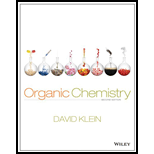
(a)
Interpretation:
To draw all resonance structures of enolate ion formed from the given set of compounds and predict whether a substantial amount of starting
Concept introduction:
Keto-enol isomerization is possible when a keto group present in the compound has a movable hydrogen atom in the next carbon attached to the carbonyl group. This occurs generally in almost all keto compounds where a chemical equilibria is present between the keto and enol form of the compound. Conversion of keto to its enol form is known as keto-enol tautomerisation. This conversion occurs in presence of acid or base. The ion fomed after the deprotonation using base at the
Symmetrical ketone=Symmetrical
Unsymmetrical Ketone=Unymmetrical
To Draw : The resonance structure of enolate ion and predict whether substantial amount of starting ketone will be present after equilibrium if sodium ethoxide is used as base.
(b)
Interpretation:
To draw all resonance structures of enolate ion formed from the given set of compounds and predict whether a substantial amount of starting ketone will be present with enolate after equilibrium when treated with sodium ethoxide.
Concept introduction:
Keto-enol isomerization is possible when a keto group present in the compound has a movable hydrogen atom in the next carbon attached to the carbonyl group. This occurs generally in almost all keto compounds where a chemical equilibria is present between the keto and enol form of the compound. Conversion of keto to its enol form is known as keto-enol tautomerisation. This conversion occurs in presence of acid or base. The ion fomed after the deprotonation using base at the
Symmetrical ketone=Symmetrical
Unsymmetrical Ketone=Unymmetrical
To Draw : The resonance structure of enolate ion and predict whether substantial amount of starting ketone will be present after equilibrium if sodium ethoxide is used as base.
(c)
Interpretation:
To draw all resonance structures of enolate ion formed from the given set of compounds and predict whether a substantial amount of starting ketone will be present with enolate after equilibrium when treated with sodium ethoxide.
Concept introduction:
Keto-enol isomerization is possible when a keto group present in the compound has a movable hydrogen atom in the next carbon attached to the carbonyl group. This occurs generally in almost all keto compounds where a chemical equilibria is present between the keto and enol form of the compound. Conversion of keto to its enol form is known as keto-enol tautomerisation. This conversion occurs in presence of acid or base. The ion fomed after the deprotonation using base at the
Symmetrical ketone=Symmetrical
Unsymmetrical Ketone=Unymmetrical
To Draw : The resonance structure of enolate ion and predict whether substantial amount of starting ketone will be present after equilibrium if sodium ethoxide is used as base.
(d)
Interpretation:
To draw all resonance structures of enolate ion formed from the given set of compounds and predict whether a substantial amount of starting ketone will be present with enolate after equilibrium when treated with sodium ethoxide.
Concept introduction:
Keto-enol isomerization is possible when a keto group present in the compound has a movable hydrogen atom in the next carbon attached to the carbonyl group. This occurs generally in almost all keto compounds where a chemical equilibria is present between the keto and enol form of the compound. Conversion of keto to its enol form is known as keto-enol tautomerisation. This conversion occurs in presence of acid or base. The ion fomed after the deprotonation using base at the
Symmetrical ketone=Symmetrical
Unsymmetrical Ketone=Unymmetrical
To Draw : The resonance structure of enolate ion and predict whether substantial amount of starting ketone will be present after equilibrium if sodium ethoxide is used as base.
Want to see the full answer?
Check out a sample textbook solution
Chapter 22 Solutions
Organic Chemistry
 ChemistryChemistryISBN:9781305957404Author:Steven S. Zumdahl, Susan A. Zumdahl, Donald J. DeCostePublisher:Cengage Learning
ChemistryChemistryISBN:9781305957404Author:Steven S. Zumdahl, Susan A. Zumdahl, Donald J. DeCostePublisher:Cengage Learning ChemistryChemistryISBN:9781259911156Author:Raymond Chang Dr., Jason Overby ProfessorPublisher:McGraw-Hill Education
ChemistryChemistryISBN:9781259911156Author:Raymond Chang Dr., Jason Overby ProfessorPublisher:McGraw-Hill Education Principles of Instrumental AnalysisChemistryISBN:9781305577213Author:Douglas A. Skoog, F. James Holler, Stanley R. CrouchPublisher:Cengage Learning
Principles of Instrumental AnalysisChemistryISBN:9781305577213Author:Douglas A. Skoog, F. James Holler, Stanley R. CrouchPublisher:Cengage Learning Organic ChemistryChemistryISBN:9780078021558Author:Janice Gorzynski Smith Dr.Publisher:McGraw-Hill Education
Organic ChemistryChemistryISBN:9780078021558Author:Janice Gorzynski Smith Dr.Publisher:McGraw-Hill Education Chemistry: Principles and ReactionsChemistryISBN:9781305079373Author:William L. Masterton, Cecile N. HurleyPublisher:Cengage Learning
Chemistry: Principles and ReactionsChemistryISBN:9781305079373Author:William L. Masterton, Cecile N. HurleyPublisher:Cengage Learning Elementary Principles of Chemical Processes, Bind...ChemistryISBN:9781118431221Author:Richard M. Felder, Ronald W. Rousseau, Lisa G. BullardPublisher:WILEY
Elementary Principles of Chemical Processes, Bind...ChemistryISBN:9781118431221Author:Richard M. Felder, Ronald W. Rousseau, Lisa G. BullardPublisher:WILEY





